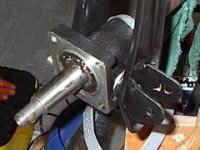guzzul
Jedi Warrior
Offline
I am rebuilding my Spitfire rear axles and am in the process of assembling the rear trunnion and positioning it on the axle shaft. I'm not sure how far along the shaft to drive the main bearing (and therefore position the trunnion).
Both the Haynes and Leyland manuals only talk about where to position the 'flinger' at the back of the trunnion. They say to position the front of the flinger at 5-3/4" from the threaded end of the axle. On my axles the flingers will drift all over the place between 5-3/4" and 6-1/8" from the end of the axle. If I push them back to where the axle shaft swells out, its around 6-1/8" from the threaded end. Maybe they're just too loose?
So where does the trunion go? Should I position the start of the flinger-recess (at the back of the trunnion) at 5-3/4" and just forget about where the flinger is? It would be helpful if the manuals indicated where the face of the main bearing should be from the end of the axle, rather than where the flinger is. The face of the main bearing is flush with the front of the trunnion.
I have (hopefully) attached a picture. Right now, I have positioned the main bearing race (and therefore the front of the trunnion) 2-1/8" from the NON-threaded start of the axle, with the thinking that the wheel-mounting flange that goes in front of the trunnion is actually 2-1/16" in depth, and the flange will not go onto the shaft any further than 2-1/16". I'm not sure if this is correct, but it makes sense to me. When I looked at the old wear patterns of where the bearings and seals were before, it would seem to be correct. At this position, the start of the flinger recess at the back of the trunnion is indeed about 5-3/4" from the threaded end of the axle, give or take.
Has anybody been through this before? Am I on the right track here? Before I drive the wheel flange on I want to make sure...that flange is a bear to get off!!
Both the Haynes and Leyland manuals only talk about where to position the 'flinger' at the back of the trunnion. They say to position the front of the flinger at 5-3/4" from the threaded end of the axle. On my axles the flingers will drift all over the place between 5-3/4" and 6-1/8" from the end of the axle. If I push them back to where the axle shaft swells out, its around 6-1/8" from the threaded end. Maybe they're just too loose?
So where does the trunion go? Should I position the start of the flinger-recess (at the back of the trunnion) at 5-3/4" and just forget about where the flinger is? It would be helpful if the manuals indicated where the face of the main bearing should be from the end of the axle, rather than where the flinger is. The face of the main bearing is flush with the front of the trunnion.
I have (hopefully) attached a picture. Right now, I have positioned the main bearing race (and therefore the front of the trunnion) 2-1/8" from the NON-threaded start of the axle, with the thinking that the wheel-mounting flange that goes in front of the trunnion is actually 2-1/16" in depth, and the flange will not go onto the shaft any further than 2-1/16". I'm not sure if this is correct, but it makes sense to me. When I looked at the old wear patterns of where the bearings and seals were before, it would seem to be correct. At this position, the start of the flinger recess at the back of the trunnion is indeed about 5-3/4" from the threaded end of the axle, give or take.
Has anybody been through this before? Am I on the right track here? Before I drive the wheel flange on I want to make sure...that flange is a bear to get off!!

 Hey there Guest!
Hey there Guest!
 smilie in place of the real @
smilie in place of the real @
 Pretty Please - add it to our Events forum(s) and add to the calendar! >>
Pretty Please - add it to our Events forum(s) and add to the calendar! >> 

 A friendly reminder - be careful what links you click on here. If a link is posted by someone you don't know, or the URL looks fishy, DON'T CLICK. Spammers sometimes post links that lead to sites that can infect your computer, so be mindful what you click.
A friendly reminder - be careful what links you click on here. If a link is posted by someone you don't know, or the URL looks fishy, DON'T CLICK. Spammers sometimes post links that lead to sites that can infect your computer, so be mindful what you click.